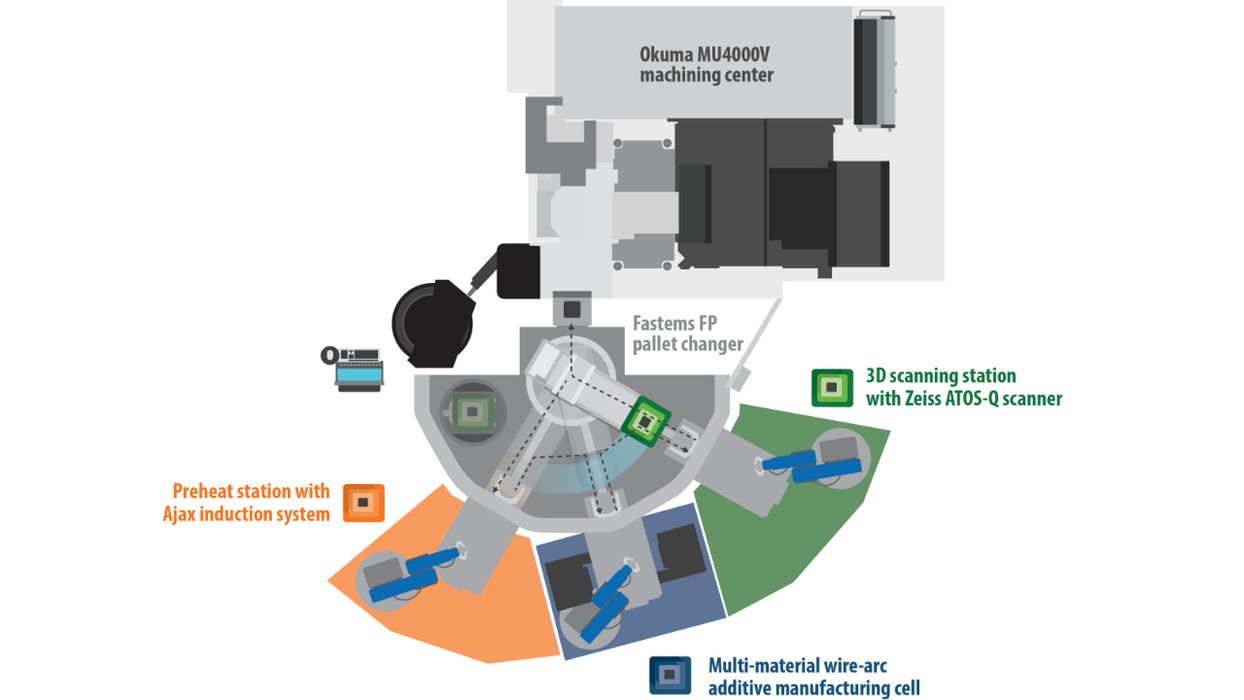
SPONSORED CONTENT
Brings Additive and Subtractive Technologies Together.
How could additive manufacturing (AM) fit into your operation? To show small- and medium-sized manufacturers just a few of the possibilities, the U.S. Department of Energy’s Manufacturing Demonstration Facility at Oak Ridge National Laboratory (ORNL) has created a convergent manufacturing platform that combines metal AM with CNC machining and other familiar processes in an innovative configuration.
The manufacturing platform, featured in the AMT Emerging Technology Center (ETC) booths #236700 and #236905 at IMTS 2024, Sept 9-14 at McCormick Place, Chicago, integrates:
- Two wire-arc additive manufacturing (WAAM) systems using arc directed energy deposition (arc DED), a metal AM technology from Lincoln Electric and software from Open Mind (booth #133351).
- Four robots from Yaskawa America (booth #236601).
- A machining center from Okuma (booth #338500), cutting tools supplied by Kennametal (booth #432324) and Zoller (booth #432018), and workholding from 5th Axis (booth #431355).
- A Fastems (booth #338966) pallet tower that enables high-speed transfer of hot work, preserves registration, enables unattended operation, and provides simultaneous production of multiple high-mix components.
- An Ajax Tocco induction heating station for pre-heating/maintaining interpass temperature.
- 3D scanning metrology station from Zeiss (booth #134302).
The convergent platform will provide three different demonstrations each day of IMTS that show how a hybrid production cell could take on familiar activities that include tooling, forging and casting replacement, and gear repair.
Tooling Demonstration
There are three killer applications for additive — tooling, tooling, and tooling — because a single tool is costly and has and it has a high value. By 3D printing a mold to near-net-shape in a fraction of the time compared to alternative processes, AM can transform the tooling industry and bring more work back to the United States.
Each day of IMTS, a tooling-oriented demonstration will produce a numbered challenge coin. The system will 3D print a coin mold, machine the interior surface smooth, and add a number representing the day of the show (one – six). A small plastic injection molding machine will create the coin.
“Every mold repair shop out there has someone welding, grinding, and machining. That’s hybrid manufacturing, but the shop owner would never call it that,” says Thomas Feldhausen, ORNL R&D staff member and principal investigator for the convergent manufacturing platform. “For example, arc DED is a term an expert would use, but shop owners would say it’s Gas Metal Arc Welding adapted to the AM process, and they’re right. We can promote AM and hybrid production by explaining our processes in familiar terms, and that’s what visitors to the ETC will get when they engage with ORNL representatives at IMTS.”
Casting and Forging
To become a qualified foundry for the U.S. Navy, providers must produce and qualify a part nicknamed the “Platypus” (as defined in the NAVSEA qualification publication T9074-BD-GIB-010_0300), which serves as the first article casting.
“Because part of our funding is through IBAS, or Industrial Base Policy to modernize the U.S. defense industrial base, we are creating a part that is directly relevant for manufacturers that want to win defense industry work,” says Feldhausen. “The way we’re doing it to start with off-the-shelf bar stock, then add features using arc DED and a nickel-aluminum-bronze filler wire.”
Feldhausen notes ORNL created the system demonstrated in the ETC using a modular approach. “We worked with great partners that helped us create the convergent platform, but we recognize that manufacturers may prefer different brands. With our model, you can replace any of the components,” he says. “We wanted the system to show how easy it is for shops to access the technology.”
Clean Energy
The third and final demonstration in the ETC simulates repairing the tooth on wind turbine gear, which is now big business because of the growth in wind power (the U.S. Energy Information Administration projects wind power generation will grow 11% from 430 billion kWh in 2023 to 476 billion kWh in 2025). The convergent platform will use AM to add material, then machine the tooth to its original dimensions.
“Combining additive and subtractive technologies together creates great benefits, and the ETC demonstration can inspire manufacturers to add more tools for their toolbox,” says Feldhausen.
As an expert in hybrid manufacturing that has used systems from most manufacturers, Feldhausen often gets asked, “What’s your favorite AM technology?” or “What’s the best machine out there if you’re looking to buy?”
“I tell people there are no right or wrong answers,” he says. “It depends on your applications, materials, and objectives. That’s why ORNL doesn’t pick winners and losers. We help people find and develop the right technologies for their operation.”
The ETC is located just off the Grand Concourse of McCormick Place at the entrance to the North Building, booths #236700 and #236905. After connecting with ORNL experts, visitors can then explore more of the processes and technologies demonstrated on the IMTS show floor — but the first step to is register for IMTS 2024.
